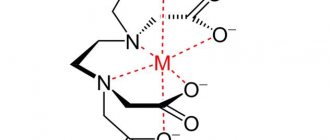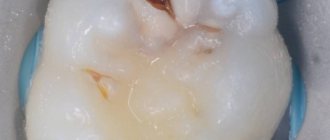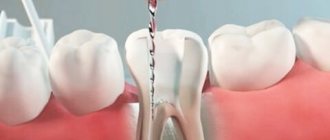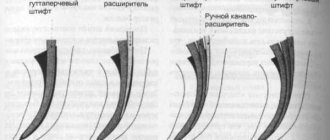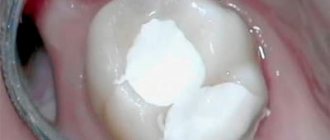A. Iandolo (Alfredo Iandolo) Doctor of Dentistry, Professor
The long-term success of endodontic treatment is closely related to adequate cleansing and quality three-dimensional obturation of the complex root canal system. Probably, a significant percentage of failures is due to the presence of residual pulp tissue and insufficient cleaning of the canals.
The endodontic system consists of spaces easily accessible for manual and machine files (main canals) and spaces that are difficult or inaccessible (delta, lateral and auxiliary canals) (Fig. 1, 2).
Rice. 1.
Rice. 2.
Regardless of the technique used, it is impossible to mechanically treat all areas of the root system. For this reason, biochemical purification is necessary. Modern endodontic treatment methods are based on old methods of work: without the help of an operating microscope, with conventional NiTi files, the use of irrigation without activation.
Endodontic treatment can be divided into stages:
- Opening the pulp chamber is the most difficult phase according to the literature, since an error at this stage may jeopardize further processing. Dissection should be performed under constant magnification and illumination.
- Forming stage using new modified NiTi tools.
- Cleansing stage using irrigant activation.
- Obturation stage.
- Of course, treatment should end with restoration.
After a thorough analysis of the X-ray and clinical examination data, endodontic treatment can begin.
Opening the pulp chamber
The first step is to isolate the surgical field using a rubber dam. Then, with constant magnification and illumination, we must begin to open the pulp chamber using rotary instruments and ultrasonic tips.
The main function of an operating microscope (Fig. 3) is the ability to distinguish between two points that are very close to each other. The human eye is essentially unable to distinguish between two points separated by a minimum distance of 0.1 mm; it will sum them up as one image. When using an operating microscope, the resolution power increases from 0.1 mm to 0.005 mm, which is 5 microns and allows the human eye to discern more details.
Rice. 3.
Ultrasonic instruments include different types of tips that have different shapes and lengths (Fig. 4). In addition, with the introduction of new and improved ultrasound sources, it has become possible to optimize the use of each type of nozzle with the ability to control the frequency and amplitude of vibration. Ultrasonic handpieces guarantee greater precision thanks to their reduced dimensions, which provide a greater view of the working area than rotary instruments.
Rice. 4.
Only after identifying the orifices (Fig. 5) is it possible to continue treatment.
Rice. 5.
Medical Internet conferences
After analyzing the market for dental products, six representatives of MPEI were selected for comparative characteristics of properties. The contenders have different generations of instruments.
We will be the first to study the characteristics of the fifth generation EMR “Protaper universal treatment”, then the representative of MPEI No. 1. This system has three options for the length of the working part of the tool: 21/25 and 31 mm; there are two types of tools: “shaping” and “finisher”. The first is intended for shaping the canal, and the second is for finishing the apical third of the canal. There are also different tip diameters; “shapers” have 3 options: Sx (0.19mm) S1 (0.17mm) S2 (0.20mm); and “finishers” - F1, F2, F3, respectively, “shapers”. The advantages of the “Protaper universal treatment” system include a single sequence and color coding for the use of instruments, regardless of the shape of the root canal. Most clinical cases require only three instruments and, of course, safety due to the rounded guide of the protaper tip.
Representative of MPEI No. 2 replaced the previous test subject and has some improvements. In its work, this propaper uses wave-like movements, which promotes better removal of dentinal filings. This propaper also has an improved alloy, which reduces the likelihood of instrument fracture in the root canal. This tool has five types of dimension/taper - x1, x2, x3, x4, x5. The taper differs along the entire length of the working part, for the first two the taper both increases and decreases, and for x3, x4, x5 it is fixed in the first 3 mm of the length, then it decreases. Representative of MPEI No. 2 is the most famous of the machine files, since the fifth generation of files is the most effective and safe.
Representative of MPEI No. 3 is a fourth generation system. The file moves in different rotational directions (reciprocal movement) to avoid screwing and breaking the file in the root canal. Forward movements begin at a large angle, and return movements have a smaller angle; the full rotation cycle is 360 degrees. As a rule, only one system file is used; only the size is selected depending on the channel.
Let's consider another fourth-generation system that deserves attention - further, representative of MPEI No. 4. This system is a MEI, which is self-adapting and has the shape of a hollow lattice cylinder made of nickel-titanium alloy. This file adapts to the anatomy of the canal and is the most non-invasive method of shaping and cleaning it. The hollow design of the MEI makes it possible, using a special endomotor, to provide constant irrigation, which, in turn, improves disinfection. A special motor provides pecking and vibration movements equal to 5000 movements per minute, as well as very precise adjustment of the micromotor speed. The file is available in 3 standard sizes: 21 mm, 25 mm and 31 mm.
The representative of MPEI No. 5 has one very big difference, which is that the cross-section is not of the protaper type, but of the convex (convex) type. This type of section increases wear resistance and also provides a torsion load distributed over 3 points. Depending on the anatomy of the canal, from three to five instruments are used. The 02 taper gives this file high flexibility, which is an incomparable advantage for curved canals. ISO color coded, lengths available in 18, 19, 20 and 22 mm.
It is also necessary to consider instrument No. 6, which is the next generation of MPEI representative No. 5 - the new generation has an increased depth of the tubules on the instrument for removing dentinal chips; shortened shank 11 mm, which provides better access to molars.
Upcoming events
2021-09-01BASIC COURSE ON DENTAL IMPLANTATION WITH DR. FRIEDMAN FOR STUDENTS AND RESIDENTS (Annual course)
2022-02-05International Implantology Congress
The main properties of NiTi are shape memory and superelasticity (or pseudoelasticity), although the first characteristic is not used in endodontics. Superelasticity, or pseudoelasticity, is particularly useful because it gives the alloy the ability to flex and conform to the shape of the channel, allowing the channel to be formed in rotation while maintaining a centered position even in the presence of accentuated curvature. Thus, negative effects (perforations, steps) on the original channel path are minimized. Superelastic or pseudoelastic behavior depends on changes in crystalline organization. Although the use of NiTi offers several advantages, the use of these rotary instruments in endodontics may increase the risk of fracture compared with the use of steel instruments.
Fracture of a rotating instrument most often depends on bending resistance. There are many NiTi instruments available in dentistry today, in this study we used a new set of rotary instruments - ProTaper Next, as their use in endodontic treatment is very effective (Fig. 6).
Rice. 6.
ProTaper Next is the fifth generation of instruments, created using modern M-Wire technology, with a rectangular cross-section and an asymmetrical center of rotation. This tool, rotating in the channel, has a larger cutting surface than a tool with the same caliber, square cross-section and symmetrical center of rotation.
The rectangular cross-section and asymmetrical center reduce blade-to-wall contact, providing more debris clearance and increased flexibility. In addition, the new alloy improves resistance to tool cyclic fatigue, allowing you to work more safely even in highly curved canals (Fig. 7-10).
Rice. 7.
Rice. 8.
Rice. 9.
Rice. 10.
As shown in the literature, files are not able to contact all endodontic spaces, for this reason active cleaning is necessary to maximize the cleanliness of a complex endodontic system.
Reamers
They are made by twisting and pulling wire (for tapering), which has a triangular or square cross-section with a sharp or smooth spiral cutting edge. Usually the small sizes of this tool have a square cross-section, and the larger ones have a triangular cross-section.
Reamers are used to widen and round the canal. The main method of work is to twist half a turn (900) with extraction and simultaneous scraping of the walls and removal of dentinal filings from the canal.
However, anatomically, no canal has a circular cross-section, and all studies have shown that no canal can be prepared with only a circular shape. The file has become a universal tool for canal processing and, as a result, reamers have become less popular.
3D cleansing
The most common irrigant used for cleansing is sodium hypochlorite. Several authors have described various methods for increasing the effectiveness of sodium hypochlorite, including using more quantity and preheating.
Heated sodium hypochlorite has a greater ability to dissolve pulp tissue and clean the canal. The rate at which a chemical reaction occurs increases with increasing temperature, pressure, activation and concentration. Since the pressure within the root canal system cannot be increased, it is possible to speed up the cleansing by increasing concentration, heat and activation.
Activation is easily achieved with sound or ultrasonic sources (Fig. 11, 12). The concentration of solutions available on the market today to prevent possible irritant reactions does not exceed 6%.
Rice. eleven.
Rice. 12.
So let's move on to heating. Usually the solution is preheated to a temperature of 50°. Preheated solutions are of limited benefit as they quickly stabilize at room temperature.
New technique for heating sodium hypochlorite: working protocol
Sodium hypochlorite has a boiling point of 96°-120°. We use a heating plugger (System-B or similar). The temperature is set to 150°. The plugger used will be 30/04 so that the working length can be easily achieved without excessive preparation.
The root canal is filled with sodium hypochlorite through an endodontic needle. The plugger is inserted to a level of no more than -3 mm from the working length, and then activated. Each activation cycle lasts 5 seconds with further intervals of 5 seconds. When activated, the plugger makes short up and down movements of a few millimeters to agitate the irrigant.
The most important aspect is that there is no contact with the canal walls during activation of the plugger. After each cycle, the irrigant is replaced with a fresh solution to have a larger amount of hypochlorite with active chlorine. The activation cycle is repeated 5 times. During each activation, vapors are absorbed by the cannula.
The main indicator is the heating of the outer surface of the root in the coronal, middle, apical thirds and at the level of the apical foramen. When the irrigant was activated, the temperature on the outer surface of the root was measured with an infrared thermometer (resolution 0.1°). Using the values set in the operating protocol, no external heating above 42.5° was detected. In this way, temperatures close to 47°, which are dangerous for the periodontal ligament, can be avoided. After chemical-mechanical cleansing (Fig. 13-15), we proceed to three-dimensional obturation using thermoplastic gutta-percha.
Rice. 13.
Rice. 14.
Rice. 15.
Size and coding of endodontic instruments from 08 to 150 (ISO standard)
| Size | Diameter | Tool handle color | |
| D1 | D2 | ||
| 08 | 0,08 | 0,40 | Grey |
| 10 | 0,10 | 0,42 | Violet |
| 15 | 0,15 | 0,47 | White |
| 20 | 0,20 | 0,52 | Yellow |
| 25 | 0,25 | 0,57 | Red |
| 30 | 0,30 | 0,62 | Blue |
| 35 | 0,35 | 0,67 | Green |
| 40 | 0,40 | 0,72 | Black |
| 45 | 0,45 | 0,77 | White |
| 50 | 0,50 | 0,82 | Yellow |
| 55 | 0,55 | 0,87 | Red |
| 60 | 0,60 | 0,92 | Blue |
| 70 | 0,70 | 1,02 | Green |
| 80 | 0,80 | 1,12 | Black |
| 90 | 0,90 | 1,22 | White |
| 100 | 1,00 | 1,32 | Yellow |
| 110 | 1,10 | 1,42 | Red |
| 120 | 1,20 | 1,52 | Blue |
| 130 | 1,30 | 1,62 | Green |
| 140 | 1,40 | 1,72 | Black |
| 150 | 1,50 | 1,82 | White |
Reamer and file size specifications (ISO)
blade - working edge;
shaft - articulation with handle;
handle - handle
It is important to remember that D1 size indicates the diameter of the very tip of the tool. Dimension D2 is usually fixed at a distance of 16 mm from D1, but this can be a different distance depending on the type of tool being measured.
Color-coded handles provide easy tool selection and consistency of use rather than determining tool size.
